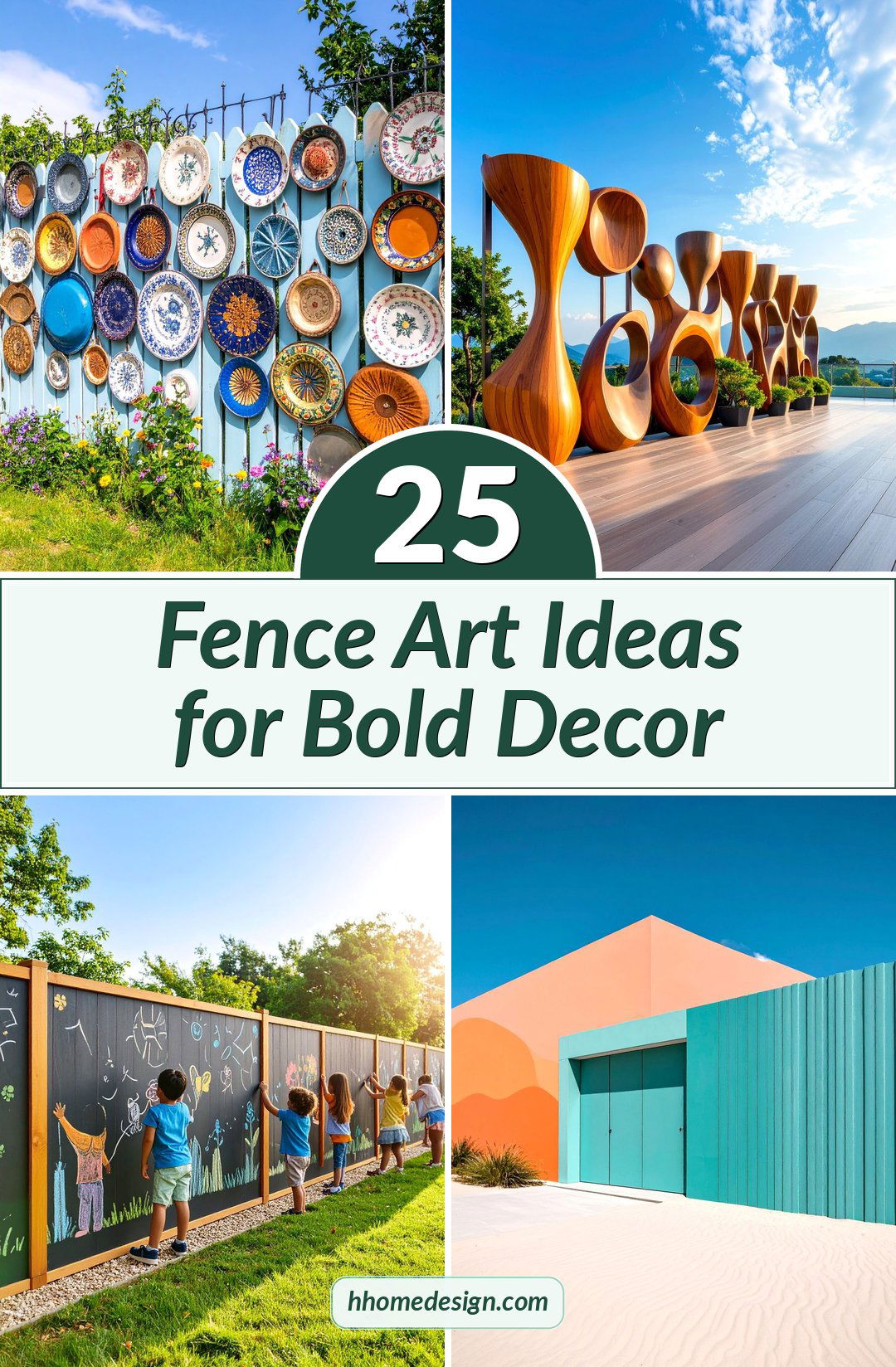
1. Botanical Mural Fence with Mixed Media Elements

Create a stunning botanical paradise by painting oversized flowers, leaves, and vines across multiple fence panels while incorporating real planters and climbing structures. This design combines painted elements with live plants, metal plant holders, and decorative trellises to create depth and authenticity. Use weather-resistant acrylic paints in vibrant colors like coral, emerald, and sunshine yellow to paint tropical blooms, then attach small metal planters filled with complementary live plants. Add climbing wire structures for real vines to intertwine with painted ones, creating a seamless blend of art and nature. This approach transforms a plain fence into a living artwork that evolves with the seasons, providing year-round visual interest through the permanent painted elements while allowing natural growth to enhance the overall composition.
2. Geometric Mirror Mosaic Installation

Design a contemporary art installation using various sized mirrors cut into geometric shapes and arranged in flowing, asymmetrical patterns across your fence surface. This sophisticated approach combines reflective surfaces with painted geometric backgrounds in neutral tones like charcoal, white, and soft gray. Install mirrors of different shapes - hexagons, triangles, and irregular polygons - using weather-resistant adhesive and secure mounting brackets. The mirrors reflect surrounding gardens, sky, and changing light throughout the day, creating dynamic visual effects that make small spaces appear larger. Paint connecting geometric patterns between mirror clusters using exterior paint to unify the composition. This design works particularly well on solid wooden fences, creating an optical illusion that transforms the fence into a kaleidoscopic art piece while maintaining sophistication suitable for modern landscape designs.
3. Vertical Succulent Garden Wall Art
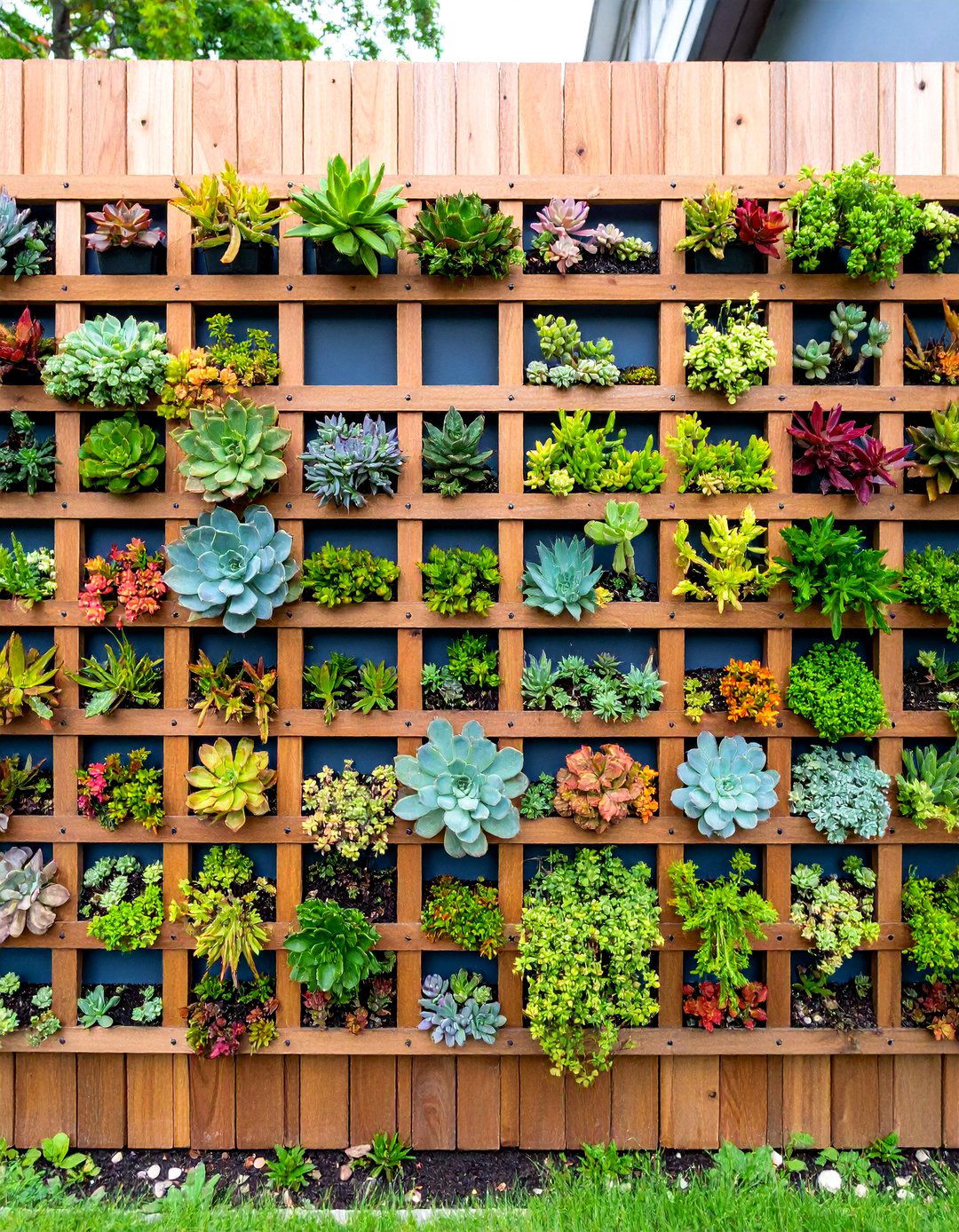
Transform your fence into a living masterpiece by creating structured succulent gardens using wooden grid frameworks, metal planters, and drought-resistant plants arranged in artistic patterns. This sustainable approach combines function with beauty, creating a low-maintenance art installation that thrives in various climates. Install horizontal wooden slats or metal grids across fence sections, then attach small individual planters, repurposed containers, or custom-built planter boxes in organized rows or flowing organic patterns. Fill with diverse succulents in varying colors, textures, and sizes - jade plants, echeveria, sedum, and colorful options like purple aeonium. The natural sculptural qualities of succulents create living art that changes subtly with growth patterns. This design provides privacy, improves air quality, and creates habitat for beneficial insects while establishing a striking visual focal point that requires minimal watering and maintenance.
4. Vintage Industrial Metal Sculpture Fence
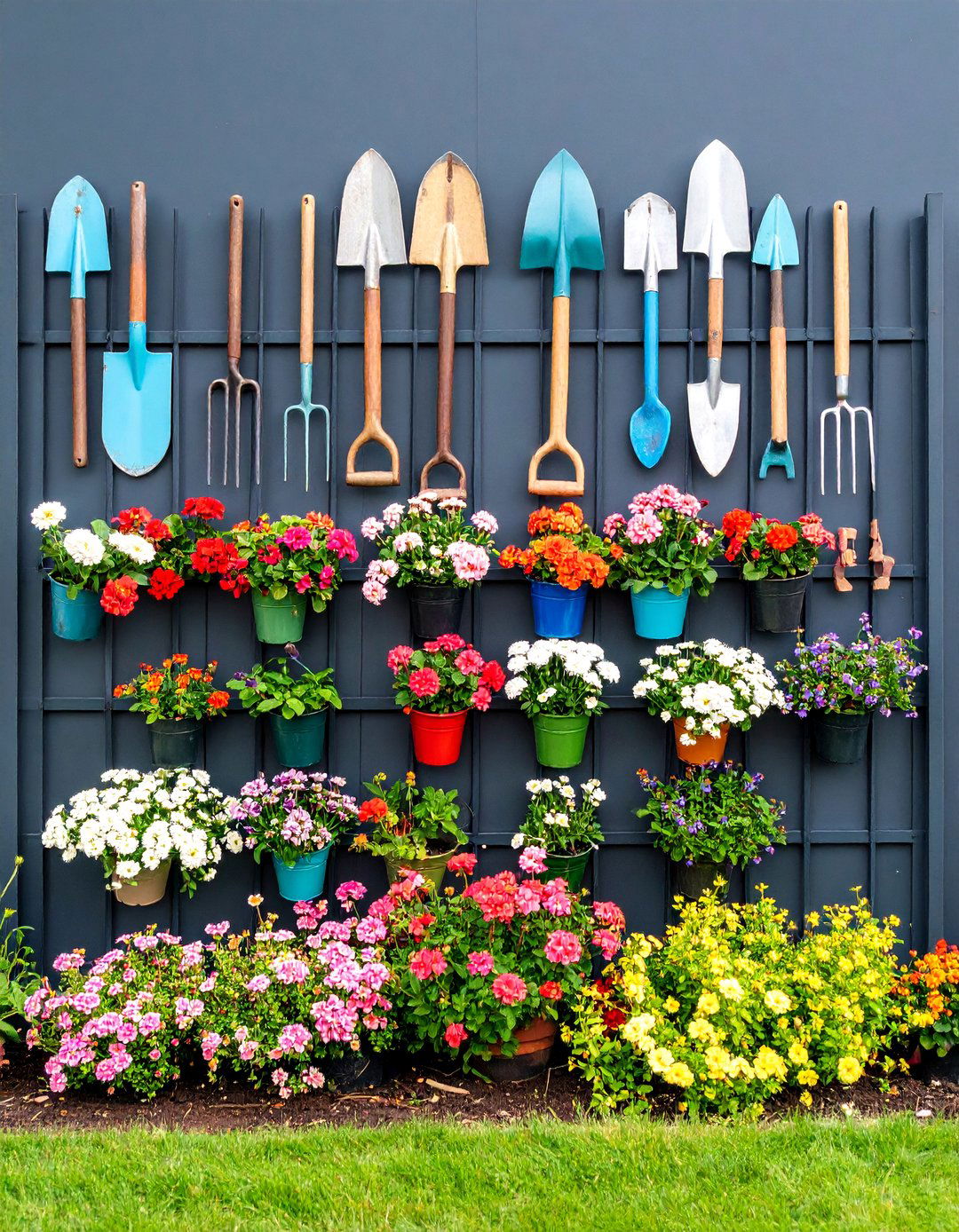
Create an industrial-chic aesthetic by mounting vintage metal pieces, sculptural found objects, and custom metalwork across your fence in an organized gallery-style arrangement. This approach celebrates industrial design through carefully curated displays of metal art pieces, vintage tools, and architectural salvage elements. Mount items like old farm tools, metal flowers, industrial gears, vintage signs, and custom-cut metal silhouettes using secure brackets and weather-resistant hardware. Paint background fence sections in deep charcoal or rust-colored tones to make metal pieces pop visually. Include LED strip lighting behind key pieces for dramatic evening illumination. This design works especially well for modern or loft-style homes, creating conversation pieces while adding character and historical reference. The key is thoughtful curation and spacing, treating each fence section like a curated gallery wall with cohesive themes and complementary pieces.
5. Interactive Lighting Art Installation
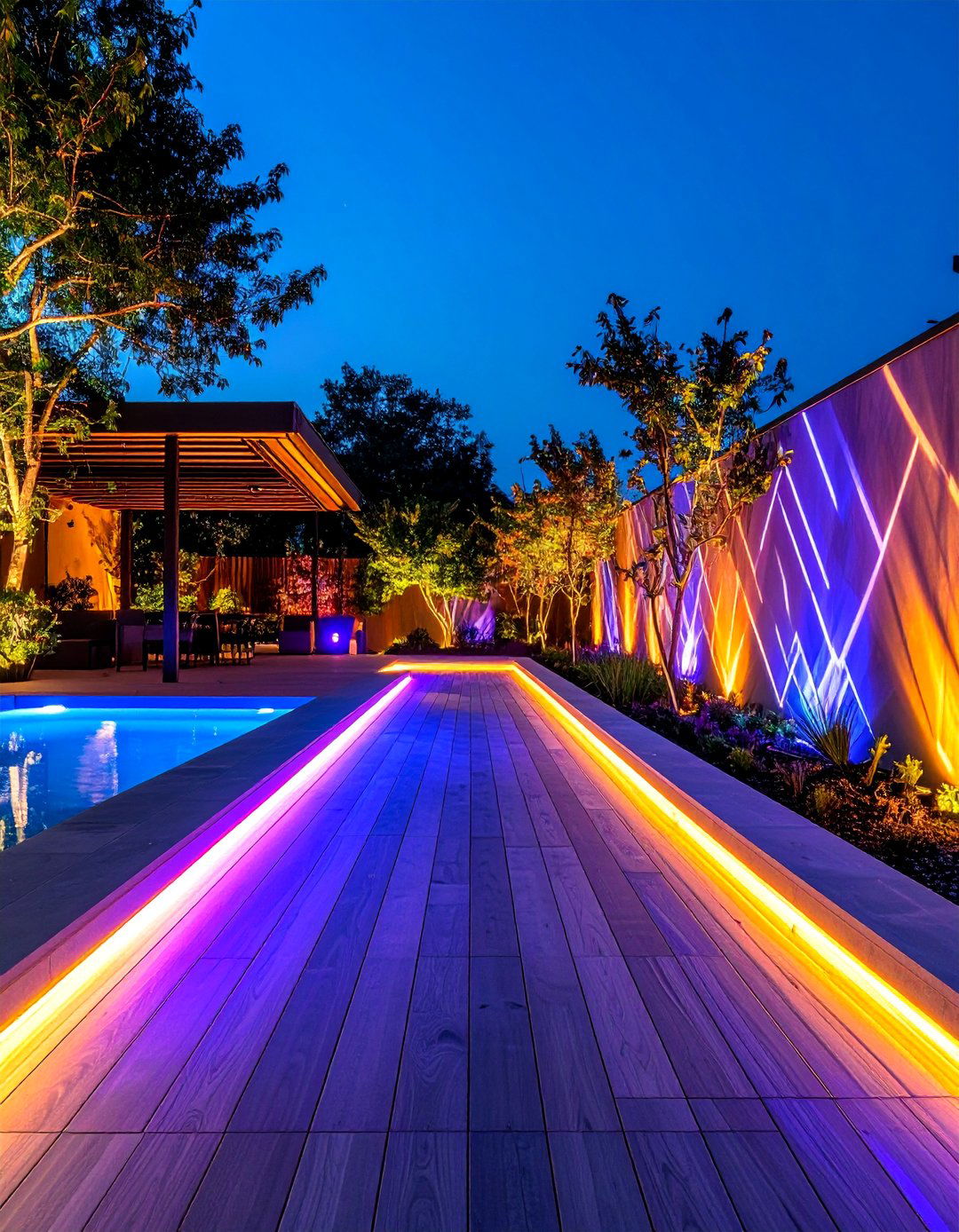
Design a dynamic fence art experience using programmable LED strips, solar-powered accent lights, and reflective elements that respond to movement and create evening entertainment. This high-tech approach combines artistic design with functional outdoor lighting, creating a fence that transforms from day to night. Install weather-resistant LED strip lighting in geometric patterns, outline painted elements, or create flowing organic shapes that follow natural fence contours. Include motion sensors that trigger color changes or pattern shifts when people approach. Add strategic placement of mirrors, metallic paint accents, or crystal elements that catch and reflect the LED lights. Solar charging systems ensure sustainable operation while programmable controls allow seasonal color changes and special occasion displays. This installation creates a unique feature for entertaining areas, providing both ambient lighting and artistic expression that makes your outdoor space feel like a contemporary art gallery.
6. Mosaic Tile Art Fence Panels

Create stunning decorative panels using broken ceramics, glass tiles, and found objects arranged in artistic mosaics that tell stories or create abstract patterns across fence sections. This durable art form withstands weather while providing permanent color and texture. Design each panel as an individual artwork or create flowing compositions that span multiple sections. Use exterior tile adhesive and weather-resistant grout to attach pieces of broken dishes, ceramic tiles, mirrors, beach glass, and decorative stones. Popular themes include flowing water patterns, floral designs, geometric mandala patterns, or abstract color compositions. Seal finished mosaics with appropriate outdoor sealers for longevity. This technique works particularly well on solid fences where tiles can be attached directly to wooden or concrete surfaces. The reflective qualities of ceramic and glass create dynamic light effects throughout the day while providing a maintenance-free art installation that improves with age.
7. Climbing Plant Framework with Artistic Supports
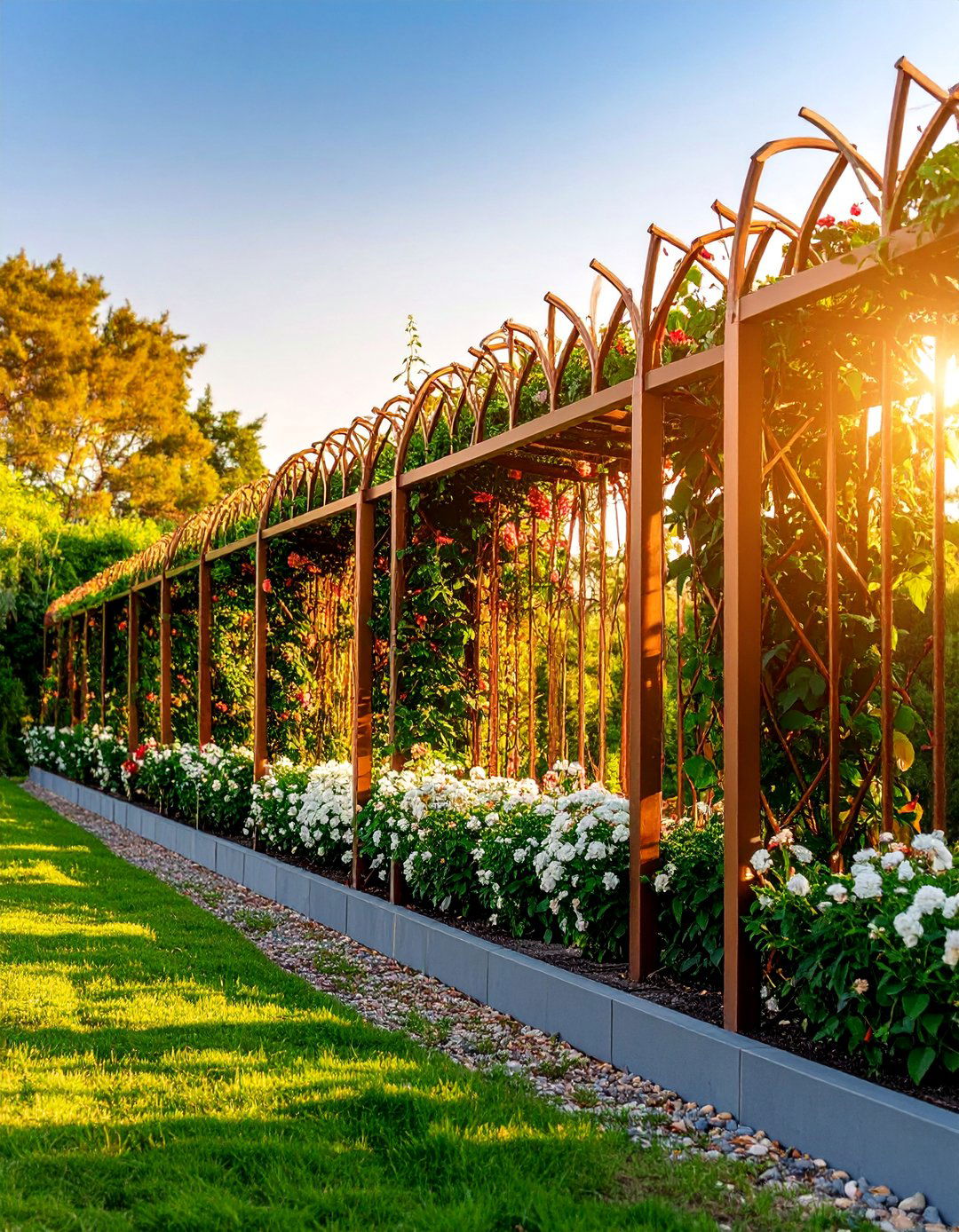
Design an integrated system where artistic metal or wooden frameworks support climbing plants while serving as sculptural elements, creating functional art that evolves naturally over time. This approach combines immediate artistic impact with long-term garden development. Install custom-designed trellises, arbors, or geometric climbing frameworks made from materials like copper, steel, or cedar wood. These structures should be artistic in their own right - flowing curves, geometric patterns, or architectural forms that complement your home's style. Plant vigorous climbers like clematis, honeysuckle, climbing roses, or annual vines that will gradually cover portions of the framework while leaving architectural details visible. Include integrated planters at the base and strategic anchor points for training plant growth. This design creates year-round interest through the permanent artistic framework while providing seasonal beauty through flowering and foliage changes, establishing a dynamic relationship between art and nature.
8. Repurposed Object Art Gallery Fence
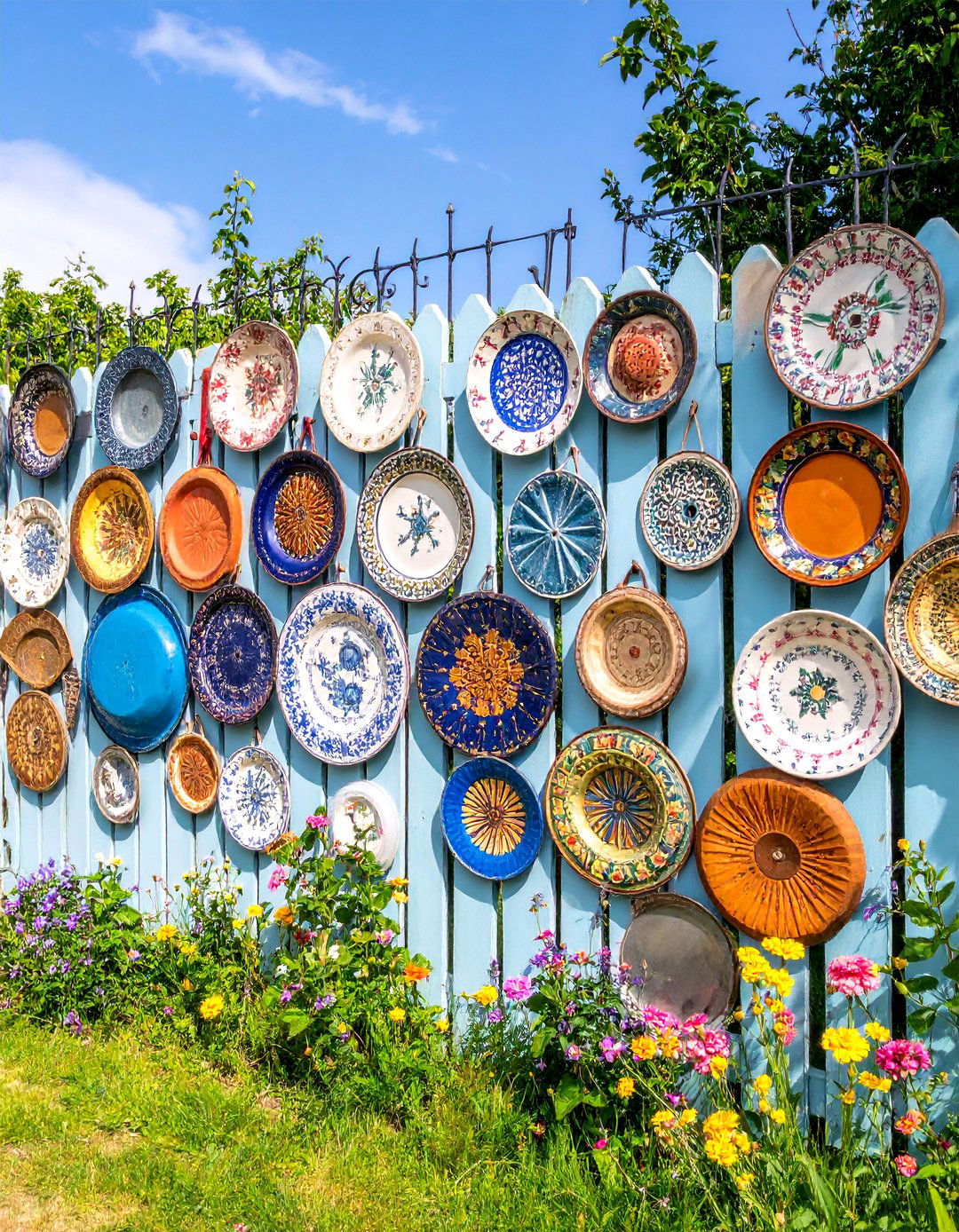
Transform your fence into an outdoor gallery showcasing creatively repurposed household items, vintage finds, and upcycled objects arranged as cohesive art installations. This sustainable approach celebrates creativity while giving new life to discarded materials. Collect and arrange items like old windows (without glass), vintage plates, metal colanders, antique tools, weathered picture frames, and architectural salvage pieces. Paint some elements in coordinating colors while leaving others in their natural patinated state. Create groupings based on color, function, or material, treating each fence section like a curated display. Include small shelves or ledges for three-dimensional objects and seasonal displays. Weather-resistant mounting hardware ensures security while allowing for seasonal changes and additions. This approach is particularly effective for cottage-style or eclectic garden designs, creating conversation pieces while demonstrating environmental consciousness through creative reuse.
9. Abstract Painted Mural with Textural Elements

Create flowing abstract compositions using bold colors and experimental painting techniques combined with added textural elements like sand, fabric, or metal accents. This contemporary approach emphasizes artistic expression over representational imagery. Begin with weather-resistant primer, then layer acrylic paints in sweeping gestures, splatters, or geometric forms. Incorporate texture by mixing sand into paint, applying fabric pieces with weather-resistant adhesive, or attaching metal strips that create raised linear elements. Color palettes might include vibrant combinations like turquoise and coral, or sophisticated neutrals with metallic accents. Consider the viewing angles and how the mural relates to surrounding landscape elements. This style works particularly well for modern homes and creates a dramatic backdrop for outdoor entertaining areas. The abstract nature allows personal interpretation while the textural elements add dimension that changes appearance with shifting light conditions throughout the day.
10. Miniature Living Wall Ecosystem

Design a complex vertical ecosystem using multiple planting levels, integrated irrigation, and diverse plant selections that create habitat for beneficial insects while providing artistic appeal. This sophisticated approach treats the fence as a vertical landscape supporting biodiversity. Install a framework of planter boxes, pocket planters, and hanging containers at various heights to create planting zones for different types of plants. Include native flowering plants for pollinators, herbs for culinary use, and trailing plants for visual softness. Integrate subtle irrigation systems using drip lines or soaker hoses hidden within the framework. Add small habitat features like bee houses, butterfly feeders, or bird nesting boxes incorporated into the design. Include educational elements like plant identification tags or seasonal bloom calendars. This installation creates a living laboratory that demonstrates sustainable gardening practices while providing year-round visual interest and supporting local ecosystems through thoughtful plant selection and habitat creation.
11. Shadowbox Garden Fence Installation
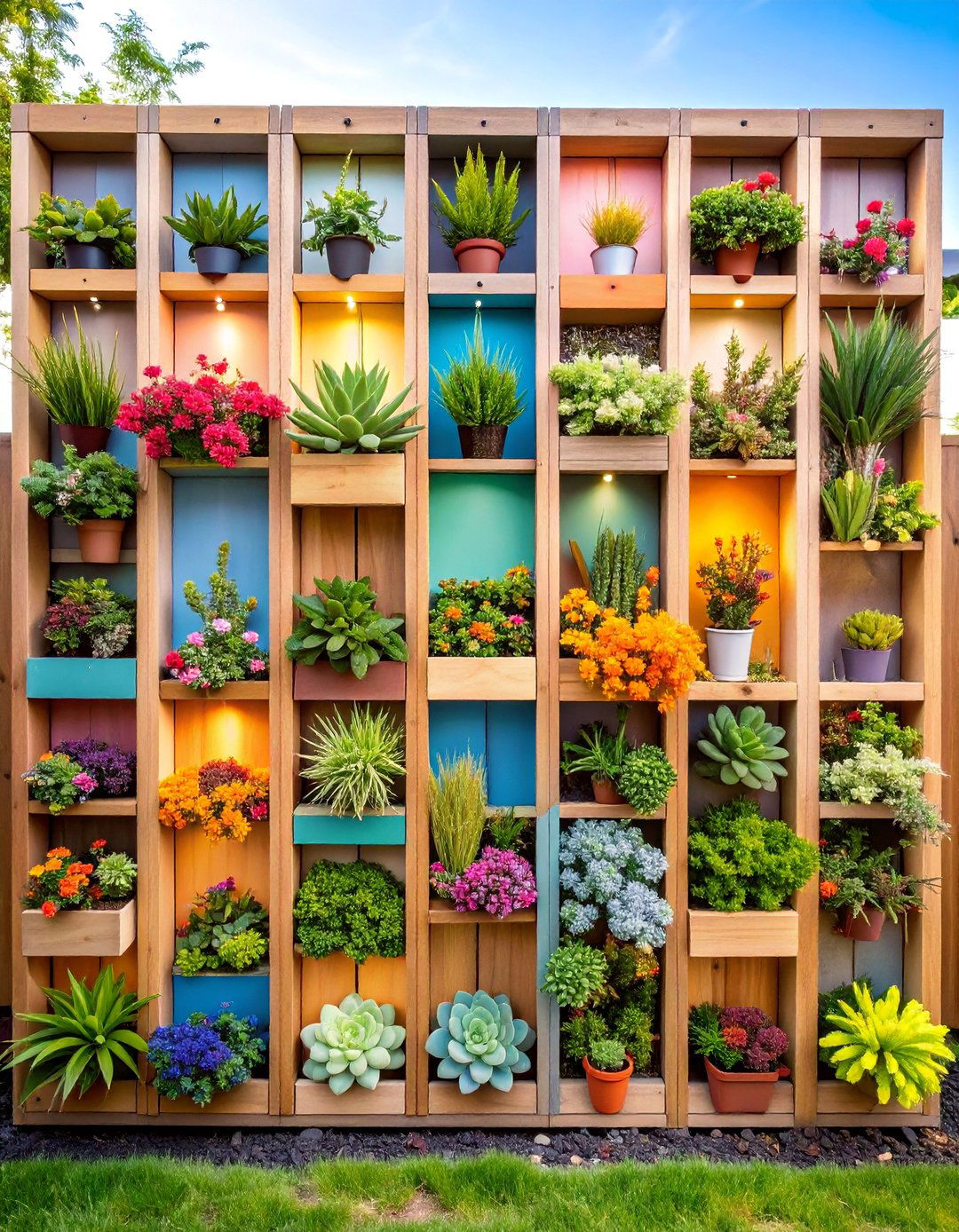
Create three-dimensional shadow boxes using recessed framing between fence posts, filling each compartment with miniature garden scenes, art displays, or seasonal arrangements. This approach adds depth and creates multiple focal points across the fence length. Build wooden frames that extend 6-8 inches from the fence surface, creating box-like display areas between posts. Each shadowbox becomes an individual vignette - miniature fairy gardens, succulent arrangements, seasonal decorations, or artistic still-life compositions. Include subtle LED lighting within boxes for evening display and weather-resistant backing materials. Removable front panels or hinged doors allow seasonal changes and maintenance access. Background colors in each box can vary or coordinate depending on the overall design scheme. This installation works particularly well for entertaining areas where guests can examine individual displays closely, creating an gallery-like experience that changes with seasons and personal creativity while maintaining structural integrity and weather resistance.
12. Woven Natural Materials Art Fence
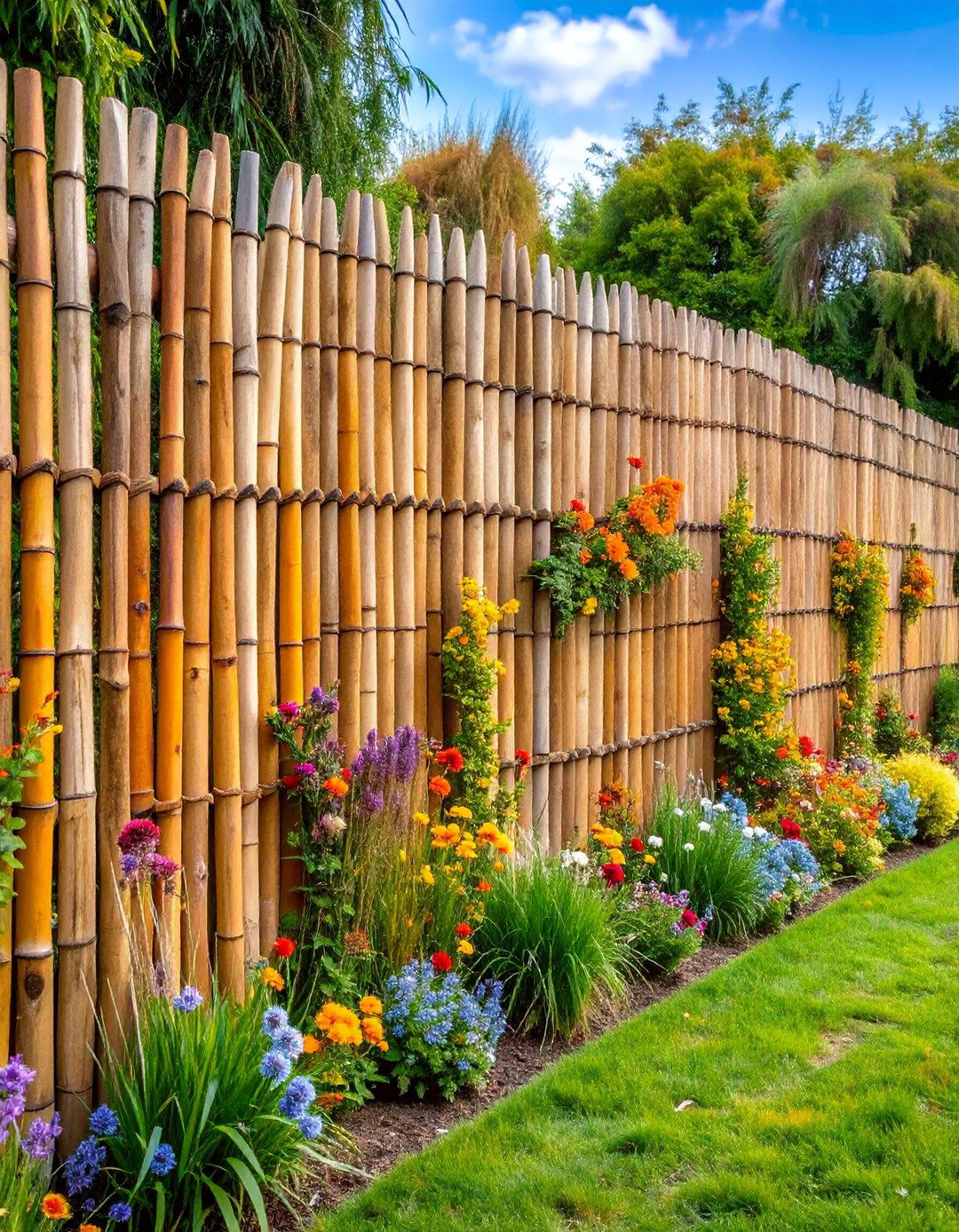
Integrate natural materials like bamboo, willow branches, dried grasses, and reed fencing into artistic woven patterns that create texture, privacy, and organic beauty. This sustainable approach celebrates natural materials while providing functional benefits. Create large-scale weaving projects using flexible materials like willow or bamboo strips woven through fence openings or attached to solid fence surfaces. Incorporate dried ornamental grasses, corn husks, or palm fronds for color and texture variation. Add structural elements like wooden frames or metal supports to contain woven sections and create defined artistic areas. This technique works particularly well with chain-link fences, transforming utilitarian barriers into artistic privacy screens. Include seasonal elements that can be refreshed annually, such as dried flower bundles or colored natural materials. The organic nature of these materials means the installation will weather naturally, developing character over time while requiring periodic maintenance to replace weathered elements and maintain structural integrity.
13. Floating Sculpture Fence Gallery

Design a series of sculptural elements that appear to float in front of the fence using concealed mounting systems, creating depth and visual intrigue through layered artistic elements. This sophisticated approach emphasizes dimensional art over flat surface decoration. Install sculptures made from weather-resistant materials like metal, stone, ceramic, or treated wood using hidden brackets or posts that create the illusion of floating objects. Pieces might include abstract metal forms, carved wooden elements, ceramic vessels, or contemporary art objects positioned at varying heights and distances from the fence surface. Paint the fence background in neutral tones to emphasize the sculptural elements, or use gradual color transitions that enhance the floating effect. Include strategic lighting that casts interesting shadows and highlights dimensional qualities. This installation creates museum-quality outdoor art displays suitable for contemporary landscape designs while providing year-round visual interest through permanent artistic elements that withstand weather conditions.
14. Seasonal Theme Rotation Fence
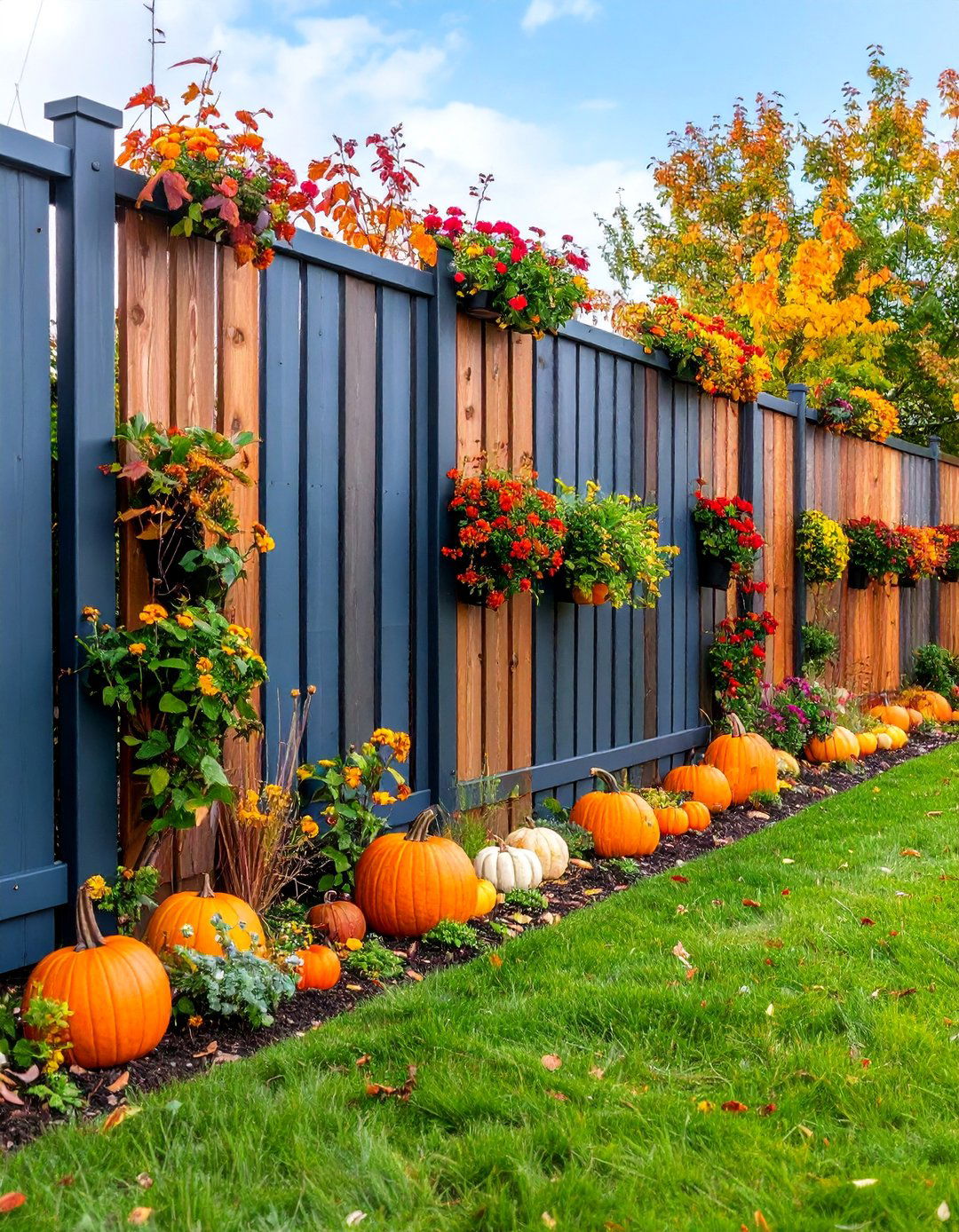
Create a flexible fence art system designed for seasonal theme changes using interchangeable panels, removable decorations, and adaptable mounting systems that transform appearance throughout the year. This dynamic approach keeps fence art fresh and engaging across all seasons. Install a base framework with standardized mounting points that accommodate different types of panels and decorations. Design seasonal themes - spring blooms, summer tropicals, autumn harvests, winter evergreens - using weather-resistant materials that can be easily changed. Include storage solutions for off-season elements and documentation of seasonal arrangements for consistent reinstallation. Incorporate both artistic and natural elements that reflect seasonal characteristics and celebrations. This system allows for personal creativity and holiday decorations while maintaining cohesive design standards. The ability to refresh the fence appearance prevents visual stagnation and provides ongoing enjoyment through creative seasonal planning and implementation, making the fence a dynamic element that evolves with natural cycles and personal inspiration.
15. Glass Art and Wind Chime Fence

Combine colorful glass art pieces with metal wind chimes and hanging elements to create a fence installation that provides both visual and auditory beauty. This multisensory approach engages multiple senses while creating movement and sound. Install weather-resistant glass pieces like fused glass panels, stained glass elements, or colored bottle bottoms using secure mounting systems that allow light transmission. Integrate metal wind chimes, hanging sculptures, and kinetic elements that move with air currents. Include different materials and sizes to create varied tones and movement patterns. Strategic placement considers wind patterns and sun angles to maximize both visual and auditory effects. This installation works particularly well in areas with regular breezes and changing light conditions, creating an ever-changing display that responds to environmental conditions. The combination of glass and metal provides durability while the movement and sound elements add life and energy to outdoor spaces, creating contemplative focal points for relaxation areas.
16. Architectural Salvage Feature Wall

Transform fence sections into architectural galleries using salvaged building elements like shutters, doors, windows, corbels, and decorative millwork arranged as artistic installations. This historically-inspired approach celebrates architectural heritage while creating unique focal points. Source authentic architectural salvage from demolished buildings, estate sales, or architectural salvage yards, selecting pieces that complement your home's style and scale. Install items using appropriate structural supports and weather-resistant hardware, ensuring pieces are properly sealed and protected from weather damage. Create groupings that tell stories or establish themes - Victorian elegance, industrial heritage, or cottage charm. Include functional elements like mirrors, planters, or lighting fixtures integrated into the architectural pieces. This approach works particularly well for period homes or gardens seeking historical character. The authentic materials and craftsmanship of salvaged pieces provide quality and character that new materials cannot replicate, creating conversation pieces while preserving architectural history and demonstrating environmental consciousness through material reuse.
17. Fabric and Textile Art Installation

Create weather-resistant textile art using outdoor fabrics, sail cloth, and synthetic materials designed to withstand environmental conditions while providing color, pattern, and movement. This soft approach contrasts beautifully with hard fence materials. Design installations using marine-grade fabrics, outdoor canvas, or synthetic textiles specifically manufactured for exterior use. Create hanging panels, stretched canvases, or flowing banners that add color and movement to fence installations. Incorporate traditional textile techniques like appliqué, embroidery, or block printing using weather-resistant materials and techniques. Include tensioning systems that keep fabrics taut and prevent wind damage while allowing controlled movement for visual interest. Color-fast dyes and UV-resistant treatments ensure longevity in outdoor conditions. This installation provides an opportunity to showcase cultural textile traditions, personal artistic skills, or contemporary fabric art while adding softness and human scale to outdoor spaces. Regular maintenance involves seasonal cleaning and inspection for wear, with the ability to replace elements as needed.
18. Multi-Level Planter Box Cascade
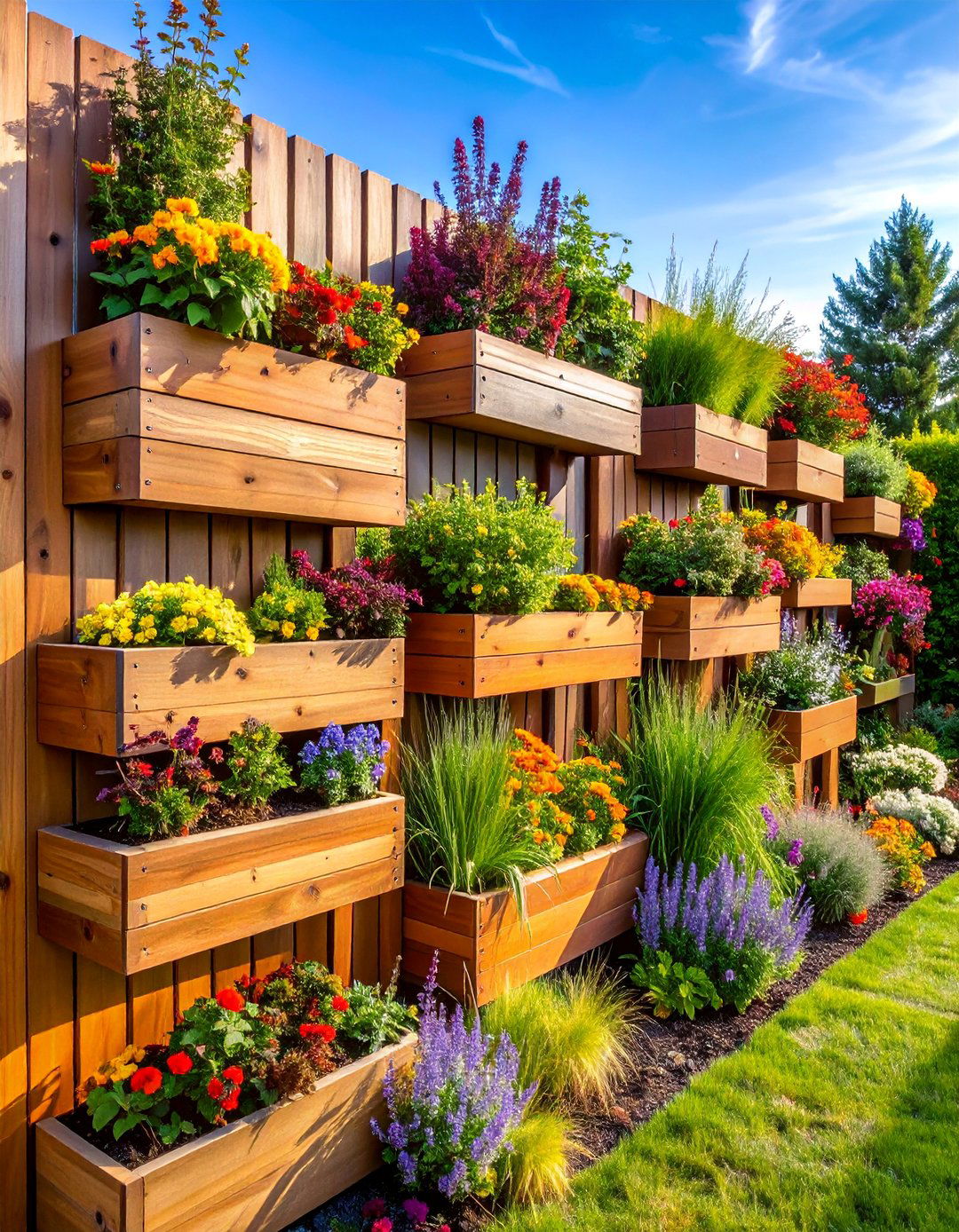
Design a stepped planter system that creates cascading levels of planted containers, combining structural elements with diverse plant selections for dynamic vertical gardening. This architectural approach emphasizes form and function through organized growing systems. Build or install planter boxes at varying heights using materials like cedar, metal, or composite materials that complement fence and landscape design. Create planting schemes that consider mature plant sizes, growing requirements, and seasonal interest patterns. Include trailing plants that soften structural edges and upright plants that provide vertical accents. Integrate irrigation systems for consistent plant care and drainage systems that prevent water damage to fence materials. This installation can accommodate diverse plant types - vegetables, herbs, flowers, or ornamental plants - depending on site conditions and personal preferences. The structured approach creates visual order while allowing plant creativity and seasonal changes. Proper construction ensures longevity while the modular nature allows for modifications and expansions as garden interests evolve.
19. Chalk Art Interactive Fence Surface
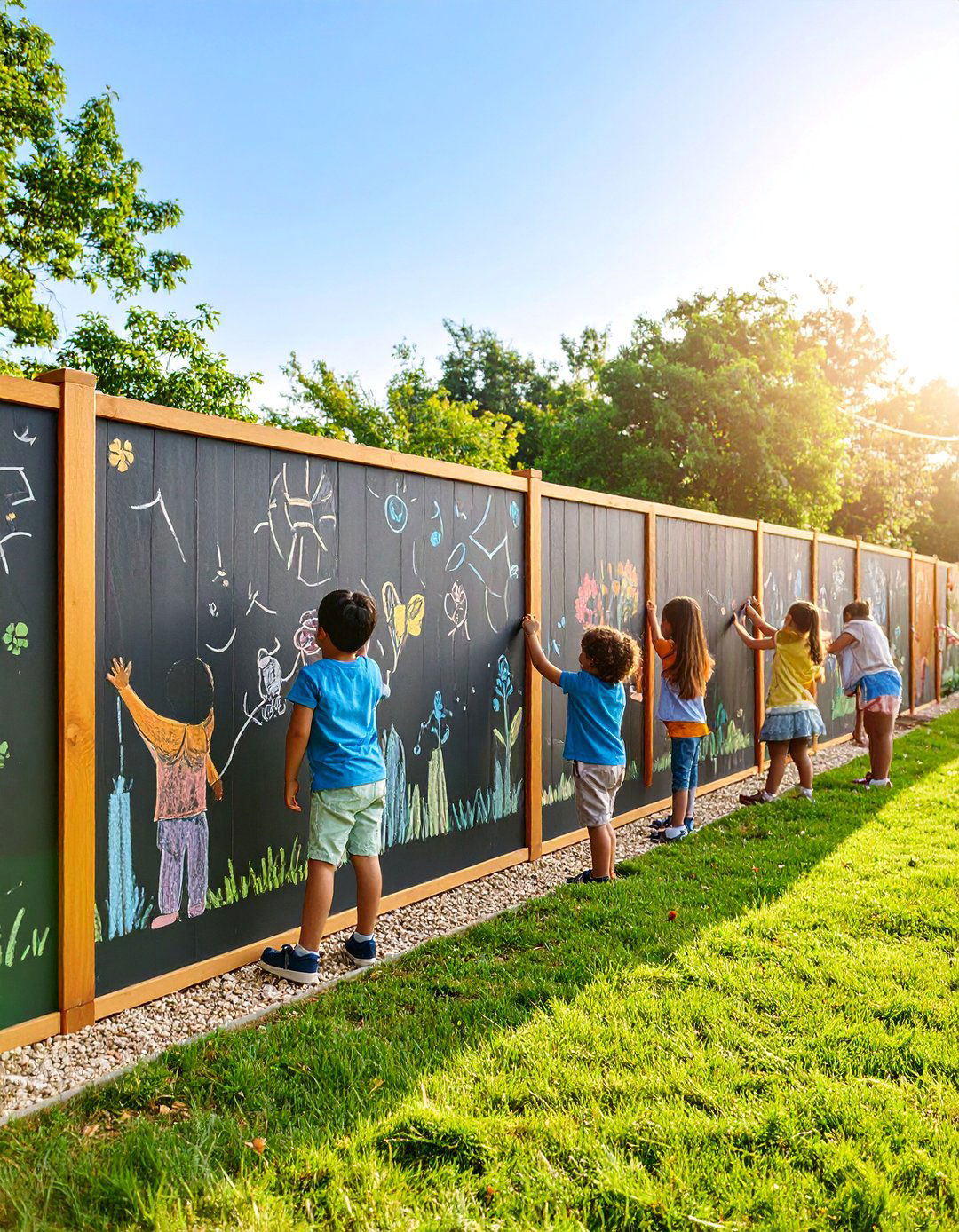
Create designated areas for temporary chalk art by installing specialized surfaces that encourage family creativity and community engagement while maintaining fence functionality. This interactive approach combines permanent installation with temporary artistic expression. Install exterior-grade chalkboard paint on specific fence sections or mount weather-resistant chalkboard panels using appropriate mounting systems. Include storage solutions for chalk supplies and cleaning materials, along with covered areas that protect active artwork from immediate weather exposure. Design the installation to accommodate different user heights and artistic abilities, including lower sections for children and higher areas for detailed adult artwork. Consider lighting for evening use and community guidelines for appropriate content and maintenance responsibilities. This installation encourages ongoing creativity and community interaction while providing entertainment for families and visitors. The temporary nature of chalk art means the installation constantly evolves while the permanent infrastructure provides lasting value and engagement opportunities throughout all seasons.
20. Kinetic Art Movement Installation

Design mechanical art pieces that move with wind, creating dynamic visual interest through rotating elements, swinging components, and weather-responsive features. This engineering-focused approach combines art with physics to create engaging installations. Install weather-resistant kinetic elements like metal windmills, balanced mobiles, rotating sculptures, or pendulum systems using proper bearings and mounting hardware designed for continuous movement. Materials should withstand constant motion and weather exposure while maintaining smooth operation over time. Consider wind patterns and movement ranges to prevent damage to fence or surrounding elements. Include various sizes and speeds of movement to create visual complexity and sustained interest. This installation provides entertainment value through movement while demonstrating principles of physics and engineering. The mechanical nature requires periodic maintenance of moving parts but provides unique visual experiences that change with weather conditions and wind patterns, creating art that is never static and always responding to environmental forces.
21. Herb and Culinary Garden Wall
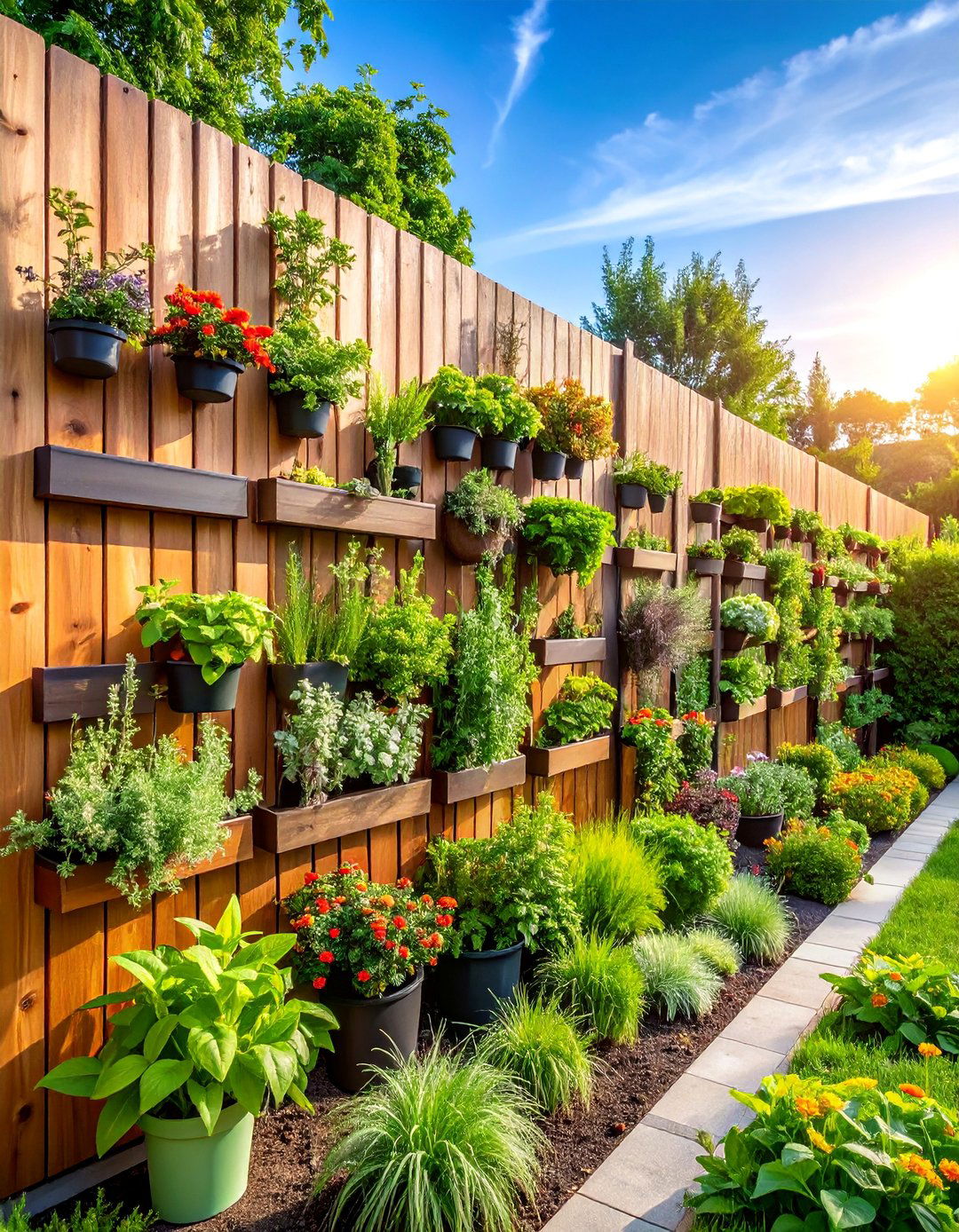
Create a comprehensive culinary garden system using wall-mounted planters, vertical growing structures, and organized herb collections that provide both artistic appeal and practical harvesting opportunities. This functional approach emphasizes edible landscaping while maintaining aesthetic standards. Install various planter types - wall pockets, railing planters, hanging baskets, and modular growing systems - arranged to accommodate different plant types and growing requirements. Include culinary herbs, edible flowers, compact vegetables, and fruit varieties suitable for container growing. Design harvest-friendly arrangements with easy access for regular use and maintenance. Include plant identification systems, harvest guides, and growing information that educate and inspire continued engagement. This installation serves multiple purposes - food production, educational opportunities, and aesthetic enhancement - while demonstrating sustainable living practices. The proximity to outdoor cooking and dining areas makes fresh ingredients readily available while the organized growing systems create visual appeal through plant diversity and productive beauty that connects outdoor spaces with culinary activities.
22. Photography Display Fence Gallery
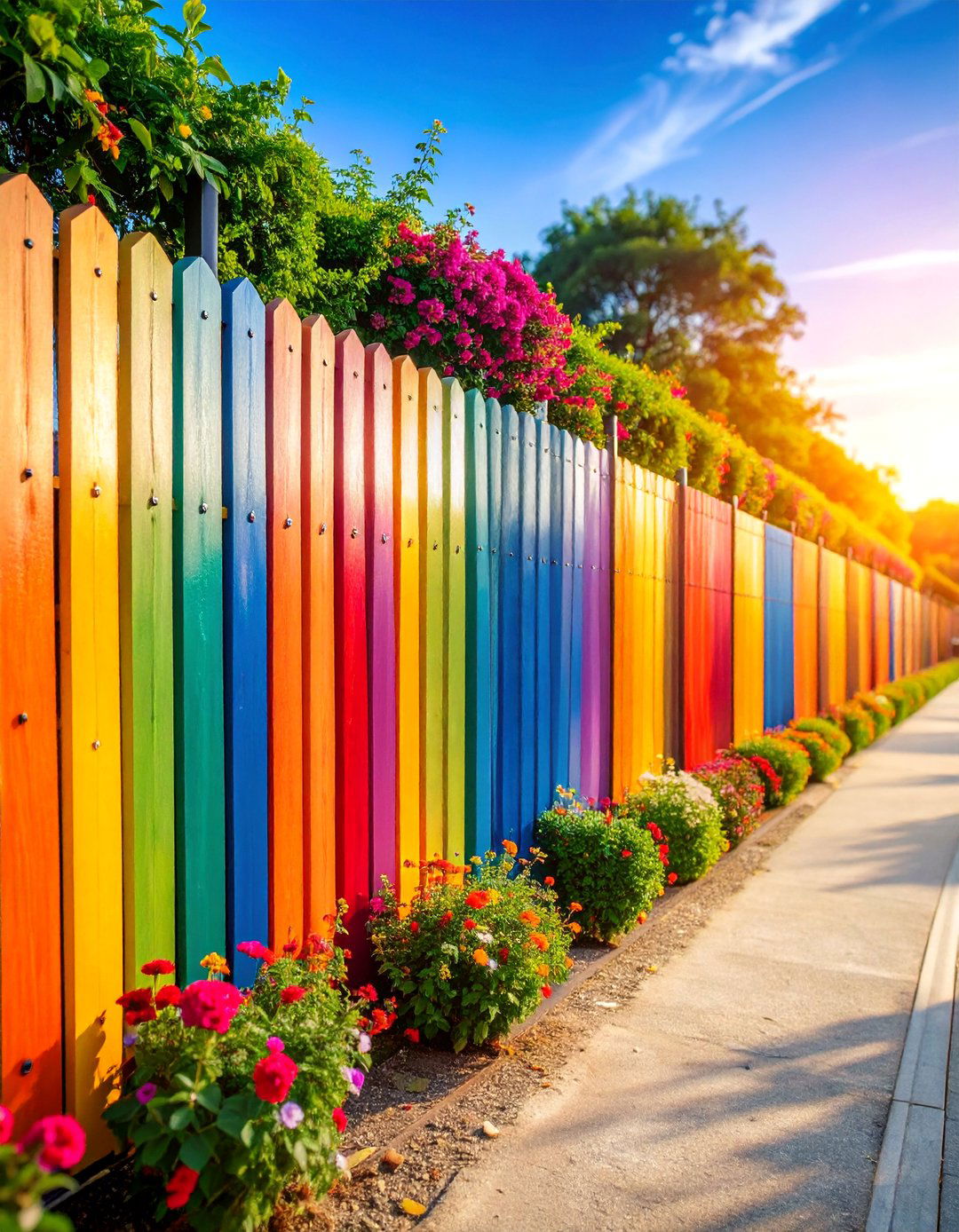
Transform fence sections into outdoor photography galleries using weather-resistant display systems that showcase personal photography, local art, or rotating exhibitions. This cultural approach brings gallery aesthetics to outdoor spaces. Install weather-resistant display cases, mounting systems, or protective enclosures designed specifically for outdoor photography display. Use UV-resistant glazing materials and proper sealing systems to protect images from weather damage while maintaining visual quality. Design flexible systems that accommodate different image sizes and allow for regular changes in displayed content. Include informational elements that provide context for displayed images and artist information. This installation can showcase family photography, local artist work, nature photography, or themed exhibitions that reflect seasonal changes or community interests. Proper installation ensures longevity of both display systems and artwork while creating opportunities for cultural engagement and community connection. The educational and inspirational value provides ongoing benefits while the ability to change displays maintains fresh visual interest throughout all seasons.
23. Sound Art and Music Fence

Create musical installations using outdoor-appropriate instruments, wind-activated sound elements, and interactive musical components that provide auditory art experiences. This sensory approach engages hearing while creating opportunities for musical interaction and education. Install weather-resistant musical elements like outdoor xylophones, wind chimes with specific tuning, drum elements, or string instruments designed for exterior use. Include both wind-activated and human-interactive elements that encourage engagement and play. Consider acoustic properties and neighborhood considerations when designing sound levels and frequency ranges. This installation works particularly well in family areas where musical education and play are encouraged. Materials must withstand weather exposure while maintaining musical quality and tuning stability. The interactive nature provides entertainment value and educational opportunities while creating unique sensory experiences that distinguish outdoor spaces. Regular maintenance involves cleaning and tuning to maintain musical quality, but the installation provides ongoing enjoyment and cultural enrichment that connects outdoor spaces with musical arts and creative expression.
24. Raised Relief Sculptural Fence
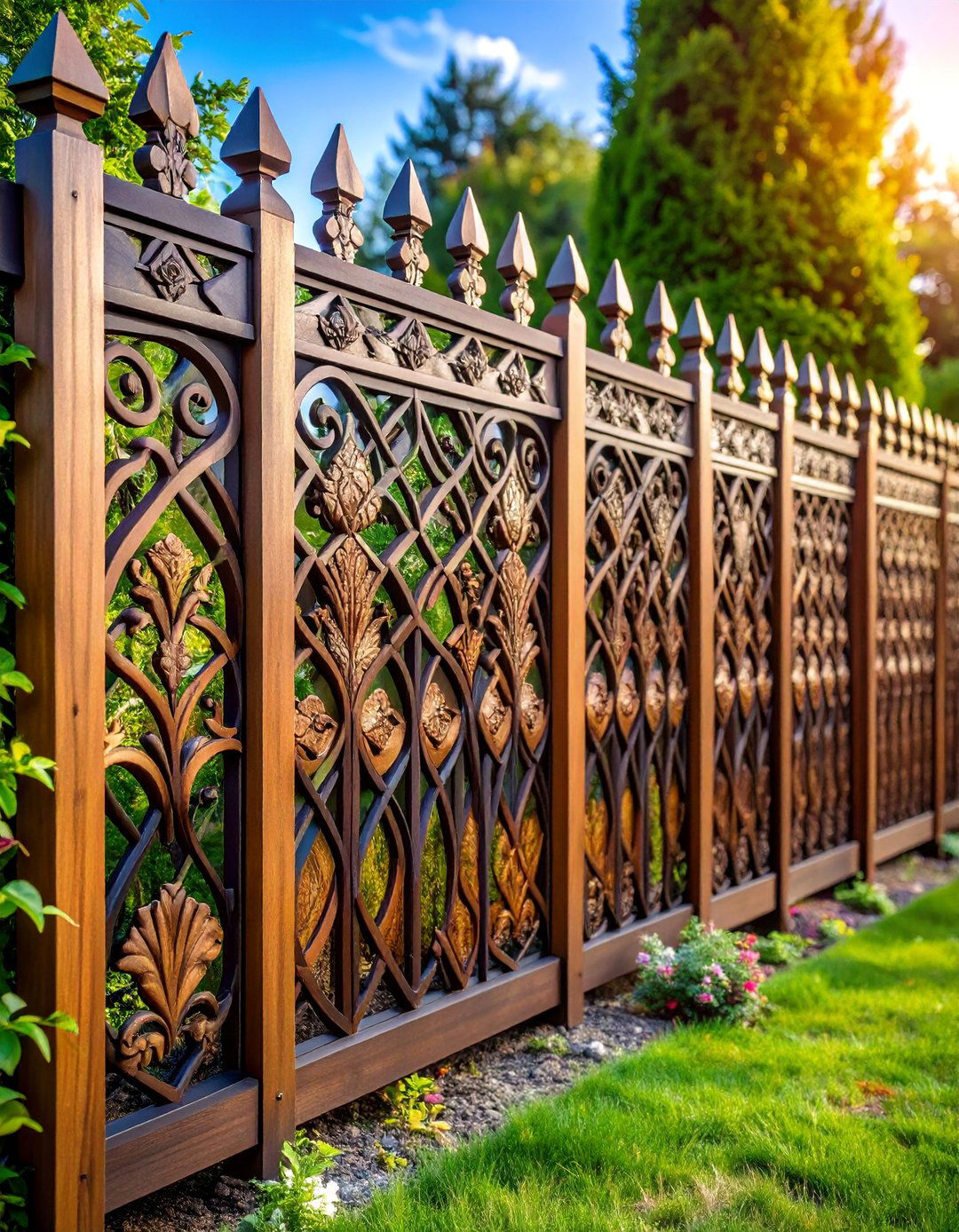
Create dimensional art installations using raised relief techniques, carved elements, and layered materials that add sculptural depth to fence surfaces. This sophisticated approach emphasizes craftsmanship and dimensional artistry. Design relief sculptures using weather-resistant materials like carved wood, molded concrete, metal appliqué, or composite materials that can be shaped and attached to fence surfaces. Create themes that reflect personal interests, natural forms, or abstract patterns that complement landscape design. Include various depths and textures that create shadow patterns and visual interest from different viewing angles. Proper sealing and finishing ensures longevity while highlighting dimensional qualities through strategic use of contrasting colors or metallic finishes. This installation provides permanent artistic value while demonstrating traditional sculptural techniques adapted for outdoor environments. The dimensional nature creates sophisticated focal points suitable for contemporary or traditional design schemes while the permanent materials ensure lasting value and continued appreciation over time. Professional installation may be required for complex sculptural elements.
25. Smart Technology Integration Fence

Incorporate modern technology like programmable lighting, weather sensors, and interactive displays that respond to environmental conditions and user interaction, creating cutting-edge fence art installations. This high-tech approach combines traditional fence function with smart home technology and artistic expression. Install weather-resistant technology components including LED lighting systems, motion sensors, weather monitoring equipment, and control systems that create responsive art installations. Program systems to respond to weather changes, seasonal cycles, or user interaction through smartphone apps or manual controls. Include sustainable power systems like solar charging and energy-efficient components that minimize environmental impact. This installation can display information like weather conditions, time, or artistic patterns while providing functional lighting and security features. The technology integration requires technical expertise for installation and ongoing maintenance but provides unique capabilities that distinguish modern outdoor spaces. Regular software updates and technical maintenance ensure continued operation while the customizable nature allows for evolving artistic displays and functional adaptations as technology advances.
Conclusion:
Fence art transforms ordinary boundaries into extraordinary expressions of creativity and personal style. These twenty-five comprehensive approaches demonstrate how thoughtful design, quality materials, and artistic vision can convert any fence into a captivating focal point. Whether you choose living installations, technological integration, or traditional artistic techniques, successful fence art requires consideration of weather resistance, maintenance requirements, and neighborhood aesthetics. The key lies in selecting approaches that reflect your personal interests while complementing your outdoor space and lifestyle needs for lasting enjoyment and value.


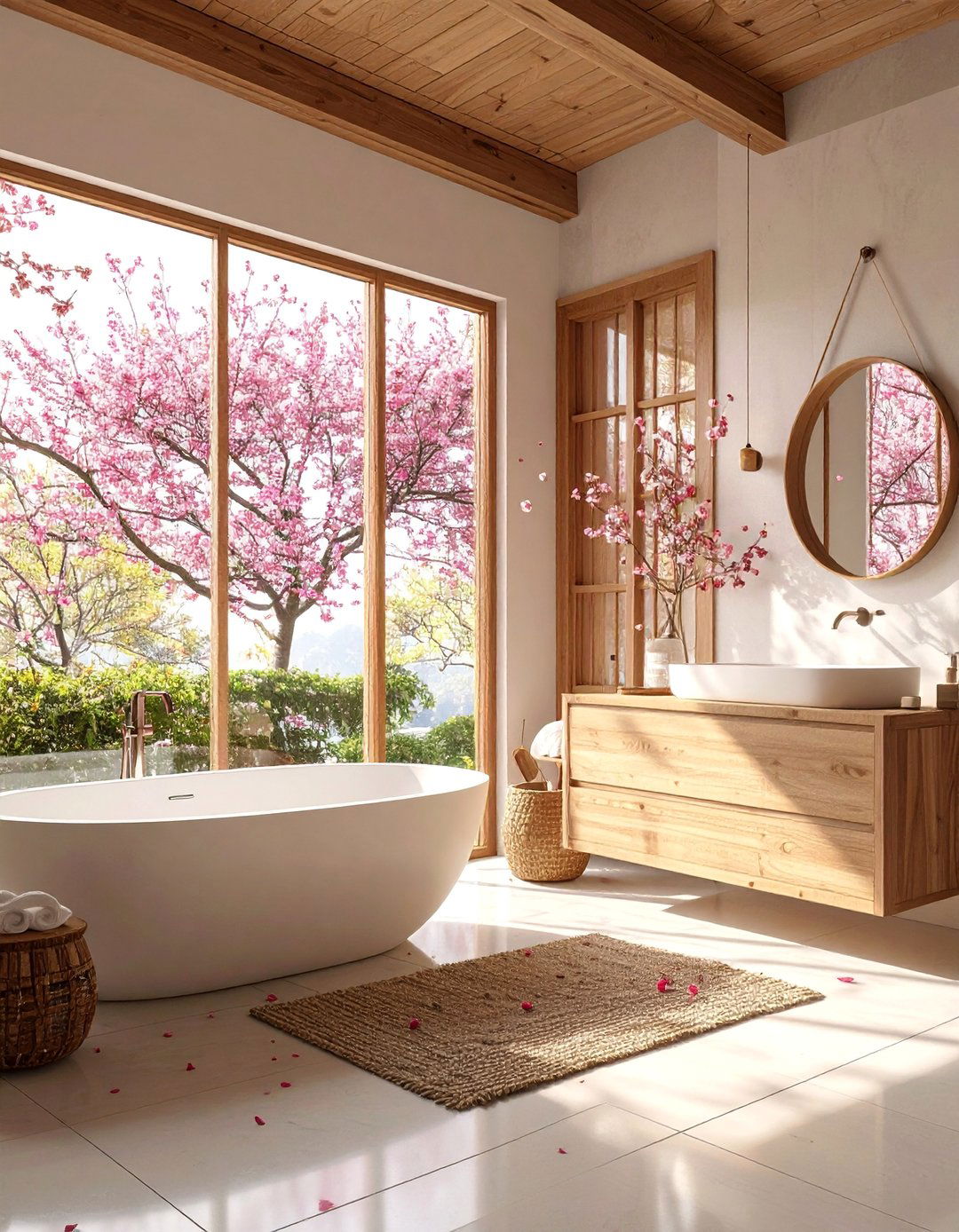

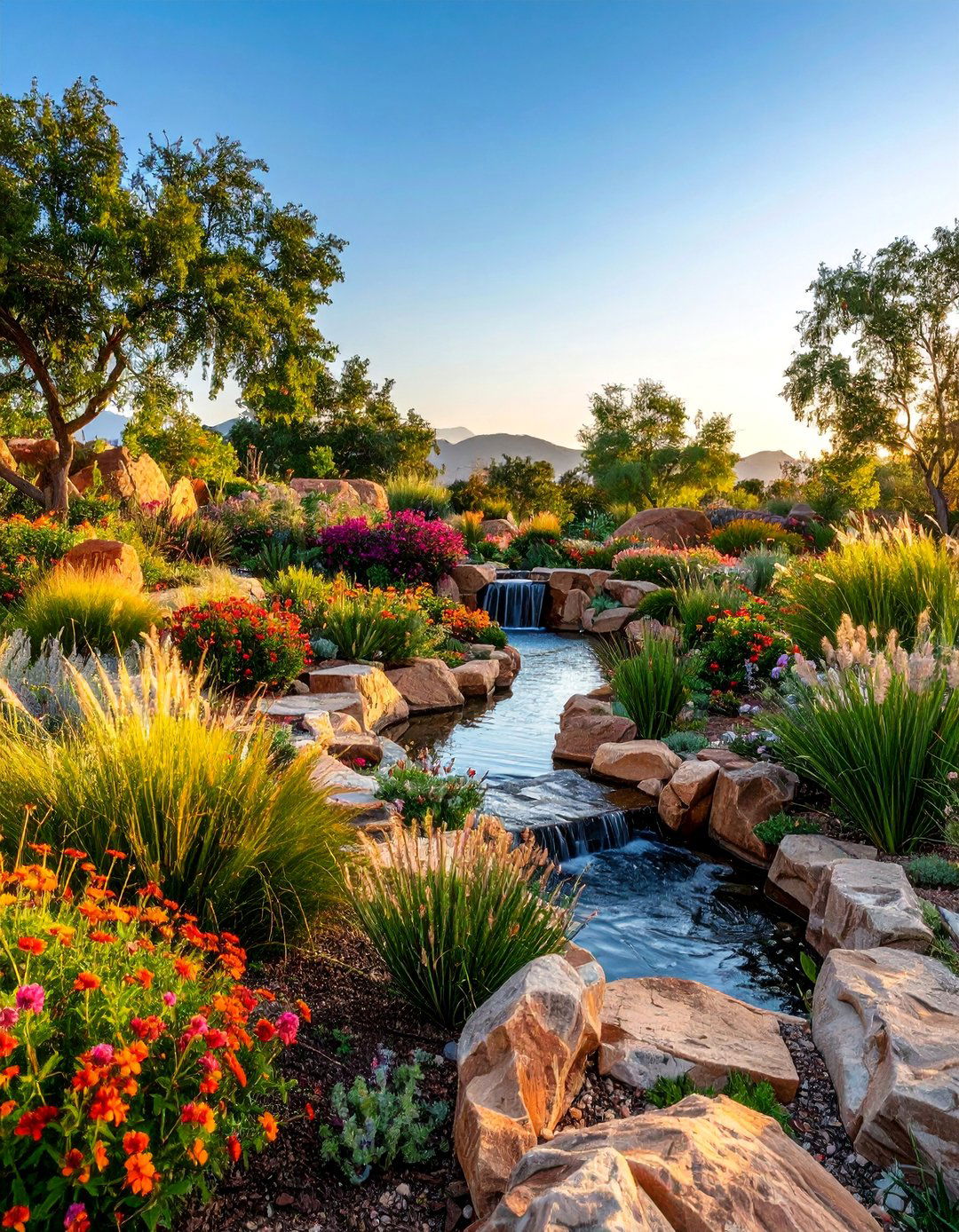
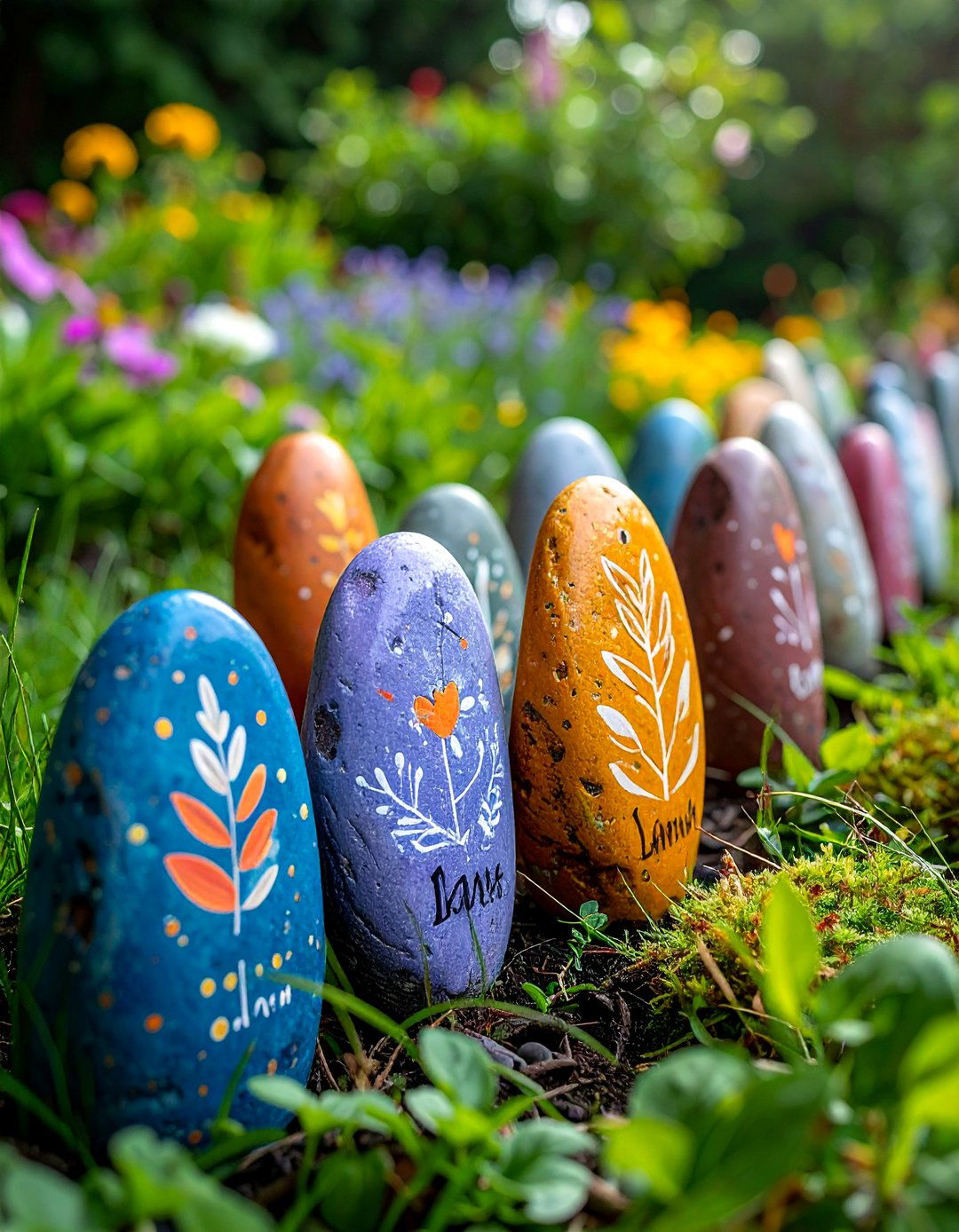



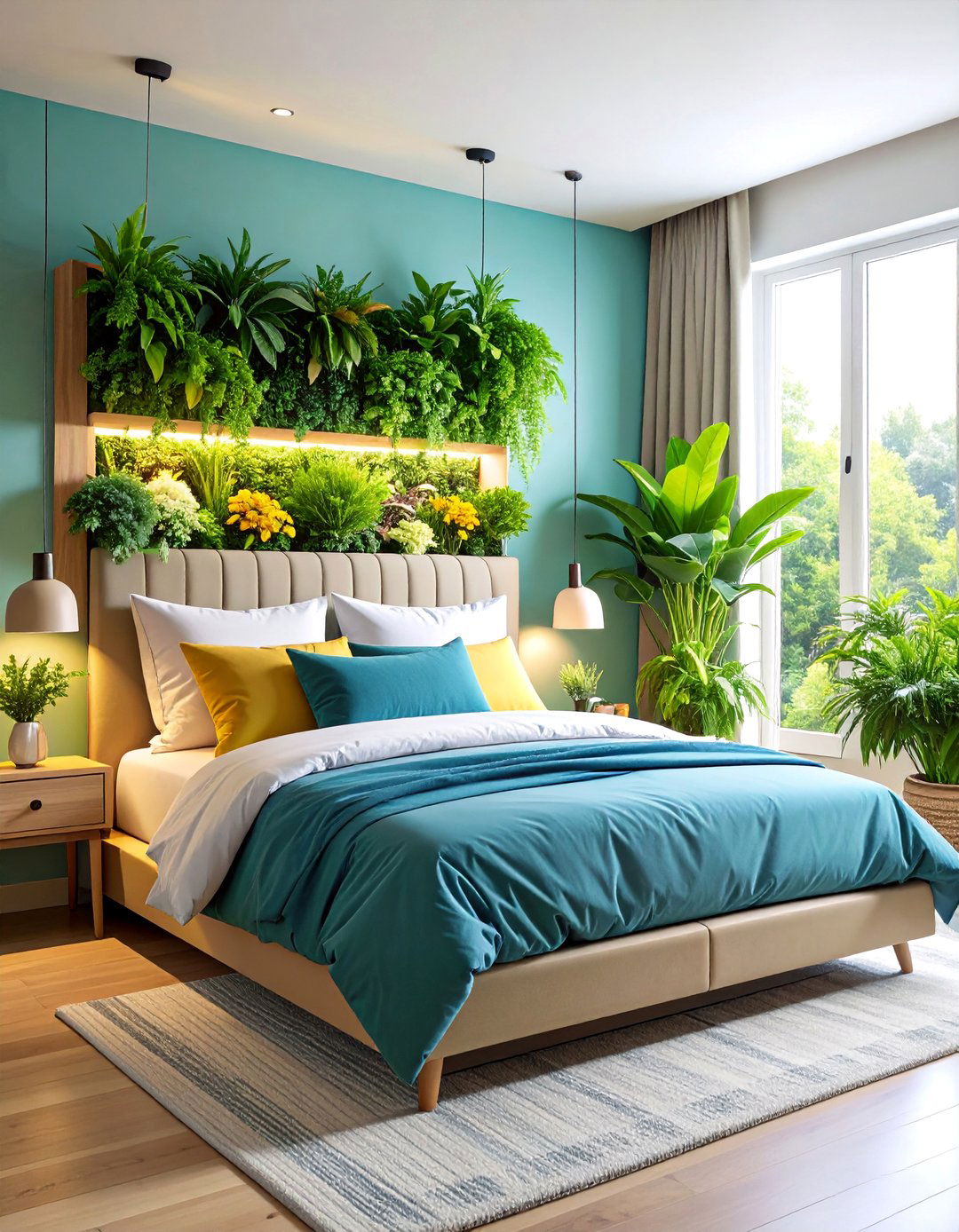

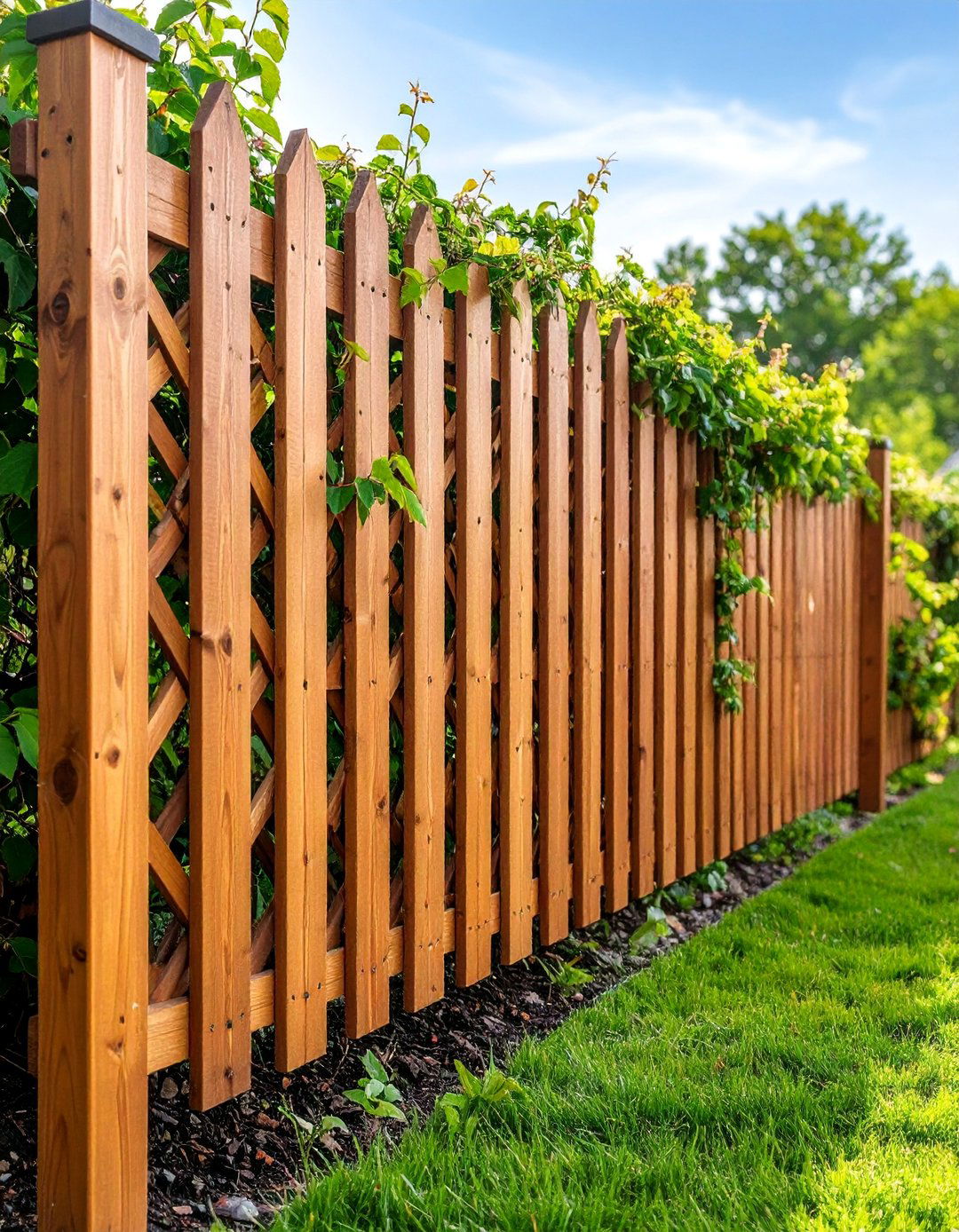
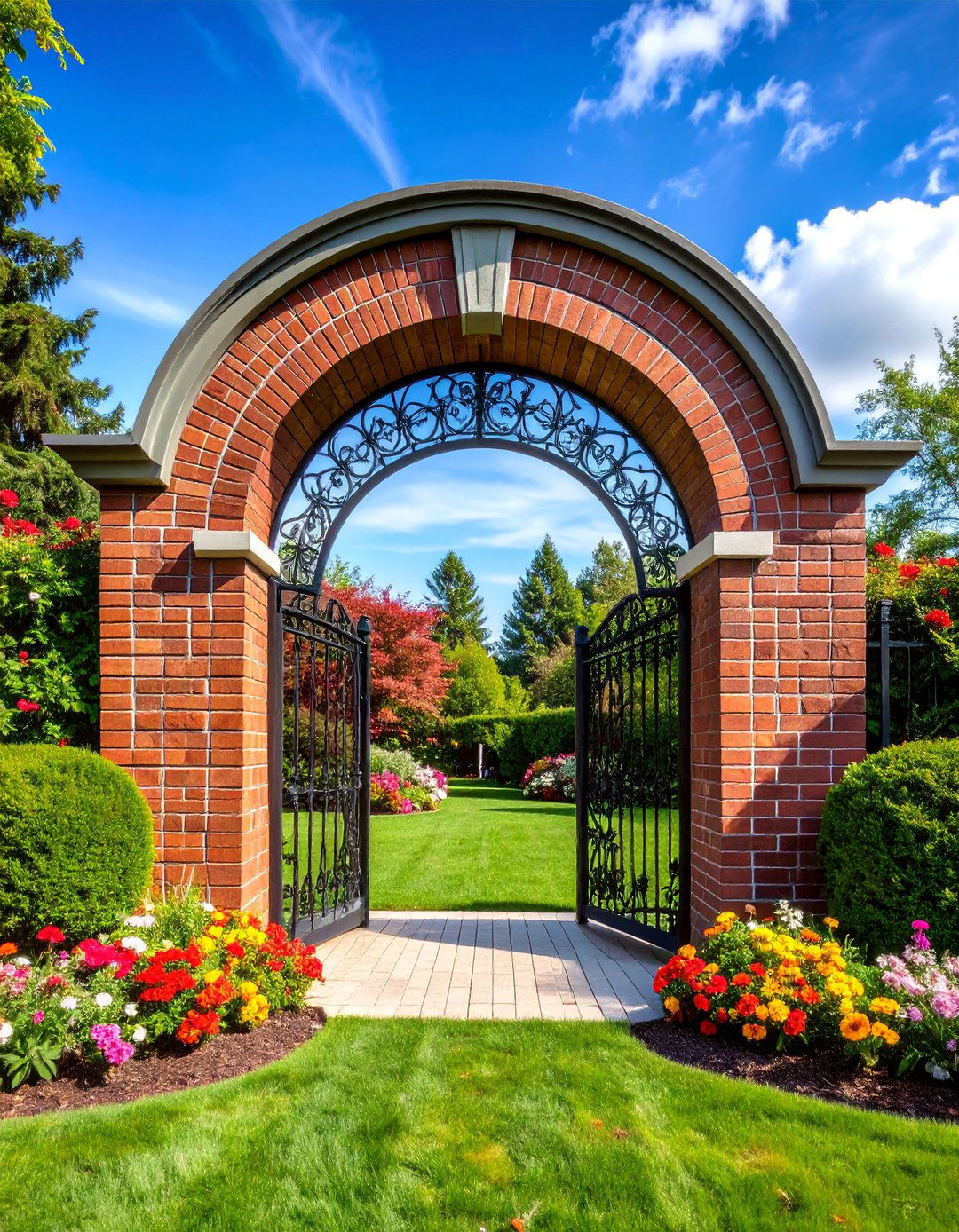
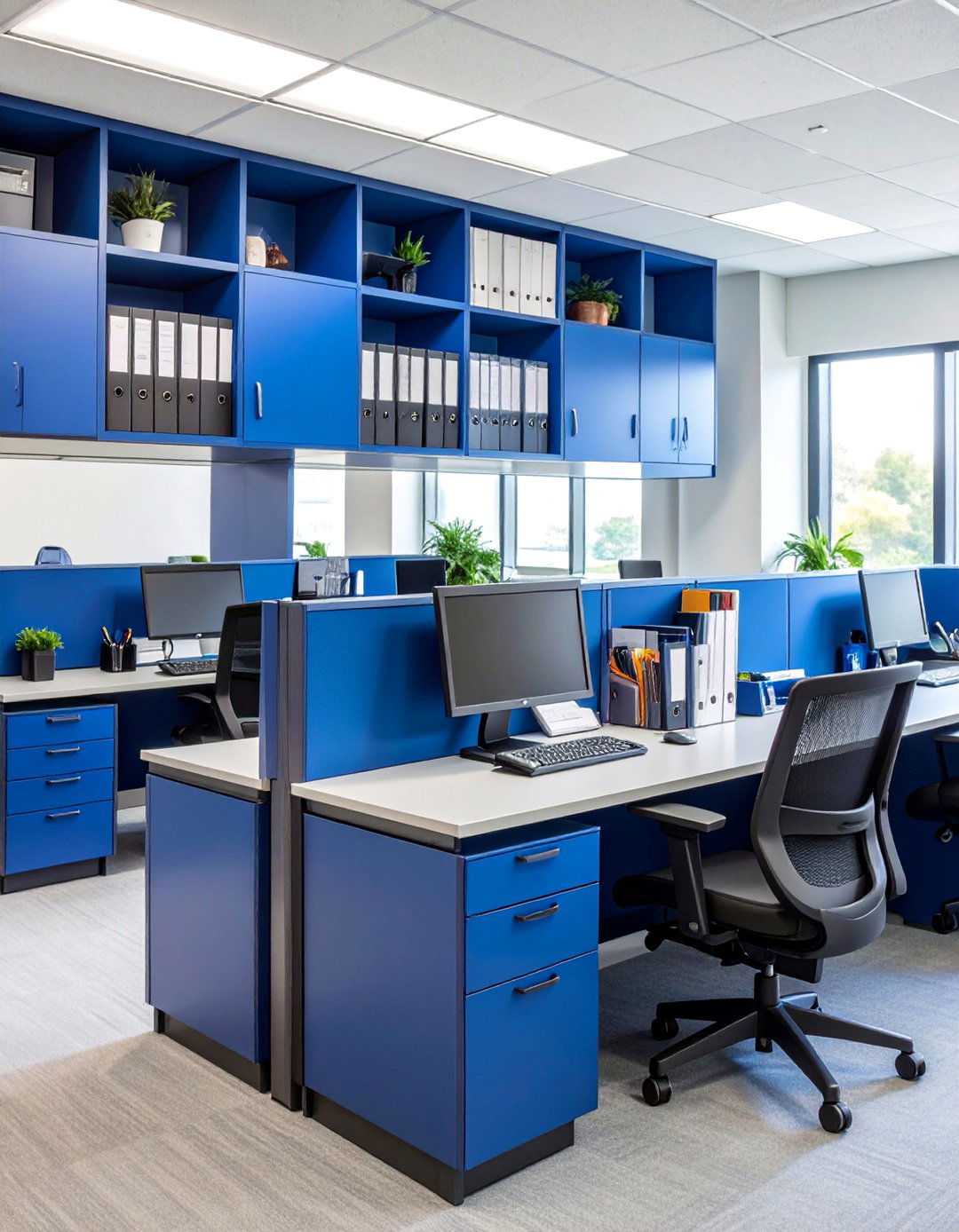
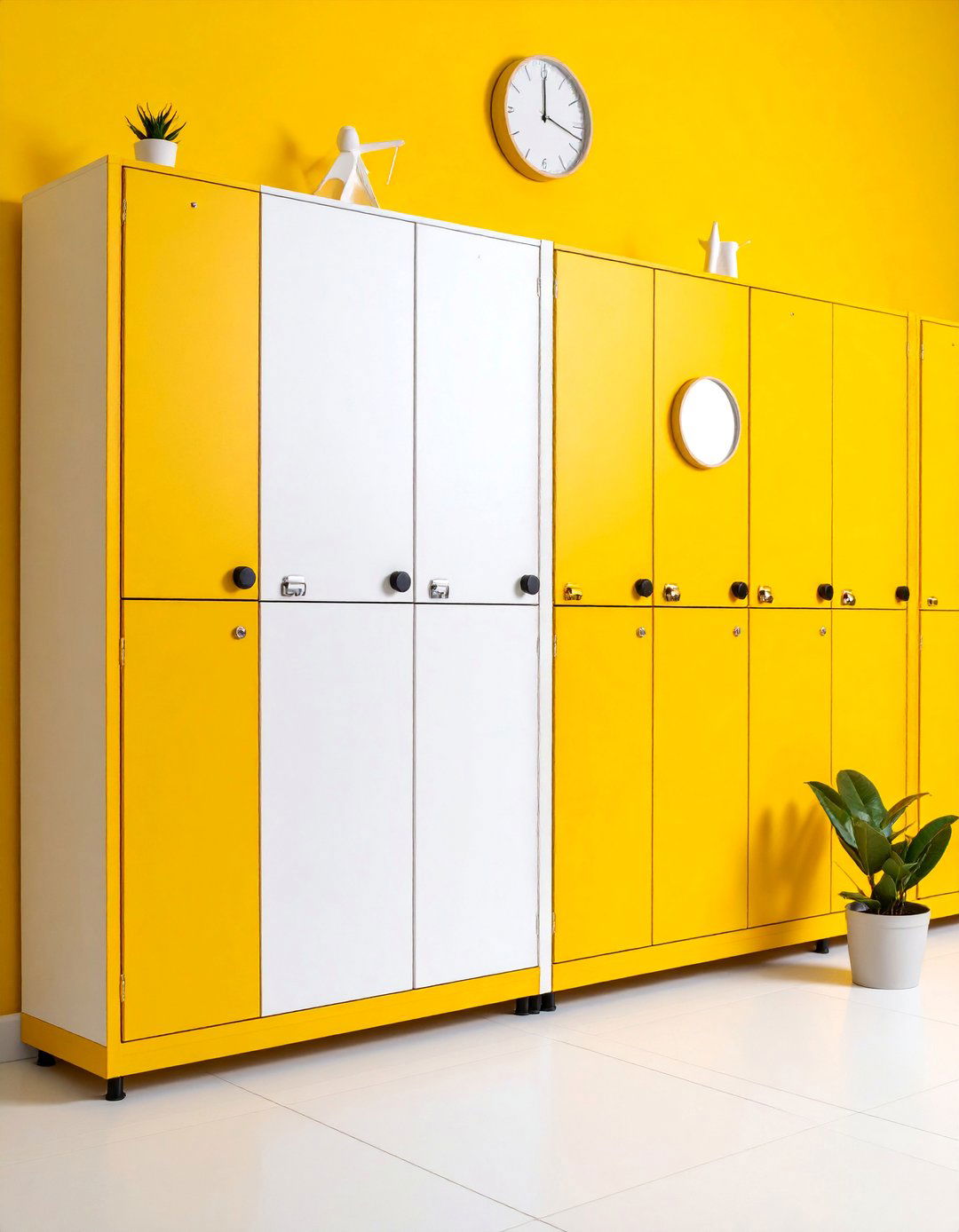
Leave a Reply